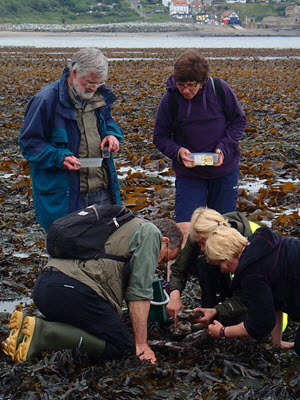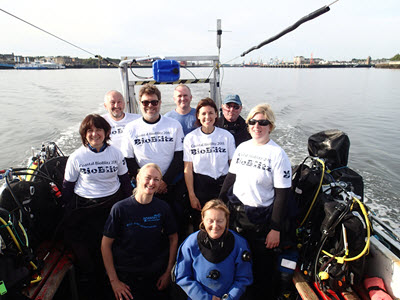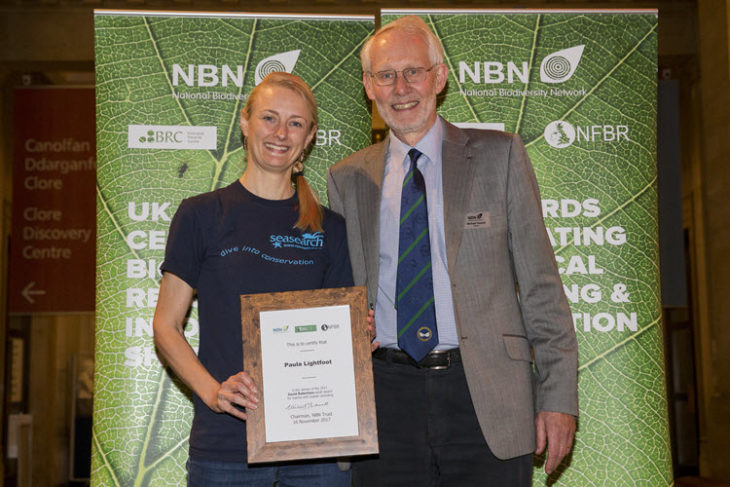Recording UK marine wildlife – a blog by Paula Lightfoot.
“The seashore is the most splendid playground in the world. There is so much to do and so much to see that we never grow tired of being there. No matter how long a time we may spend at the seaside, there are always new treasures to seek, fresh discoveries to make – always something more to interest or amuse us.”
The Sea Shore by F. Martin Duncan
Those words were written over a hundred years ago in a book for children but they are still true today, and just as true for adults as for kids – in my case anyway! You will find me exploring the marine environment at every possible opportunity, by snorkelling, diving, turning over boulders on the seashore and peering into rockpools. My home patch is the north east coast of England from Yorkshire to Northumberland. This is a beautiful and extremely varied coastline; highlights include the iconic and ever-changing Spurn Point, Flamborough’s chalk headland and sea caves, the rugged limestone cliffs and reefs of the Durham Heritage Coast, and Northumberland with its sand dunes, castles and islands.
This varied coastal landscape is home to a great diversity of colourful marine wildlife. The dense turf of red, green and brown seaweeds on rocky shores provides shelter for a multitude of animals. Beneath the waves, swaying kelp forests reveal urchins, crabs, lobsters, fishes (and if you are lucky, maybe an octopus!), while reefs and shipwrecks are covered with encrusting animals such as sponges, soft corals, sea squirts and anemones.
I try to identify and record everything I see, which is challenging and extremely rewarding. There are some excellent marine life ID guides and websites to help me improve my identification skills, including a wonderful site created by the first winner of the David Robertson award for marine and coastal recording, David Fenwick (www.aphotomarine.com). The thing that excites me most about recording is the element of discovery – finding a species that’s new to me or new to the area, or simply observing behaviour I haven’t seen before. Being able to use and contribute to the NBN Atlas is a huge motivating factor – it is very important to me to see my records in a national context and I love being able to fill gaps by putting new dots on the map!
Exciting finds: The NBN Atlas had no records of either of the species below on the English east coast – until this year!
Biological recording is not just about wildlife and habitats, it is about people too. The UK has a wealth of natural history societies, many of which have existed for over a hundred years, bringing people together to share their interests, knowledge and enthusiasm. I am a member of the Yorkshire Naturalists’ Union, the British Phycological Society (seaweeds), the Conchological Society of Great Britain and Ireland (molluscs) and the Porcupine Marine Natural History Society. I get a huge amount of enjoyment and benefit from these societies, so I try to ‘do my bit’ to play an active role in them. I organise field trips – that is the fun part! – and also help with administrative tasks, contribute articles for newsletters and talks for conferences. A newer initiative is the Seasearch national recording scheme, which celebrates its 30th anniversary in 2018. Seasearch trains SCUBA divers to record the species and habitats they see on their dives and has contributed over half a million records to the NBN Atlas. Through these natural history societies and Seasearch, I have had fantastic opportunities to take part in marine recording all around the British Isles. I haven’t holidayed abroad in the last ten years – there is so much to explore here!
Recording with friends


I am absolutely delighted to have won an award for doing what I love! It was a very proud moment when I received the David Robertson Award for recording marine and coastal wildlife at the NBN Conference in November. David Robertson was an amateur naturalist who studied and recorded marine wildlife on the Scottish island of Cumbrae in the nineteenth century, leading to the establishment of a nationally important marine research station on the island. He is a wonderful example of the UK’s great tradition of biological recording and the contribution made by amateur naturalists; it is a great honour to receive an award bearing his name and to be part of this tradition.
I am sincerely grateful to Paramo for sponsoring the awards, to the Durham Heritage Coast Partnership for nominating me and of course to all my fellow marine and coastal recorders who share my enthusiasm and make this so much fun!

